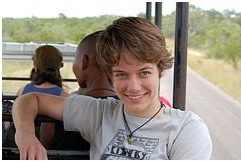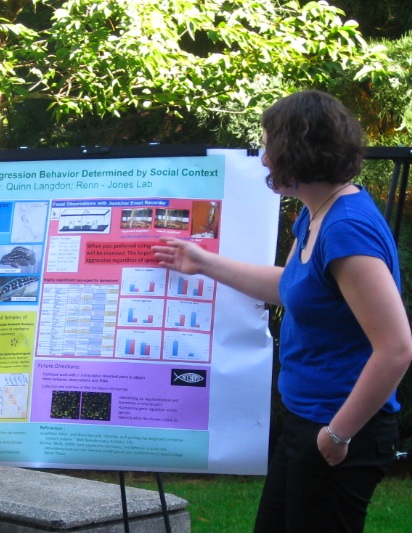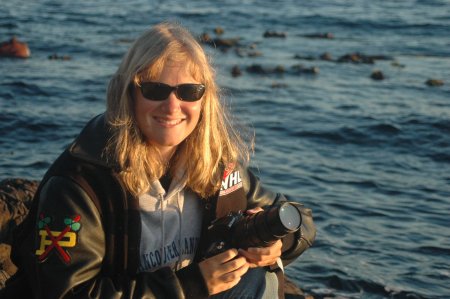Department of Biology
Renn Lab
Fish 'N Chips: Comparative Genomics and the Evolution of Behavior in African Cichlid Fishes.
Current Lab Members
Rose Driscoll
Funded by REU:NSF:IOS Behavioral Systems supplement to grant #0818957
James Fisher-Smith
Funded by Staffor Summer Research Fellowship
Madeline Robin
Funded by NSF:IOS Beahvioral Systems grant #0818957
Mical Yohannes
Funded by NSF:IOS Behavioral Systems grant #0818957
Any prospective Thesis students should look at past thesis projects, scan the "Student Projects Page" and then enquire about the possiblity of specific projects by emailing Prof. Suzy Renn renns@reed.edu
Current Postdocs
Cynthia O'Rourke
Funded by NSF:IOS Neural Systems grant
Maia Benner
Funded by NSF:DEB Population and Evolutional Processes grant
Past Thesis Students
Past Summer Research Students
Past Lab Members
Past Independent Research
PAST THESIS PROJECTS
click on the name for a short summary.
click on "thesis" for abstract and representative data.
2015 Alumni with Thesis
Chrissy Schmidt
Christina Barrett
Emmeline Hill
Emily Agan
Melissa Ashbaugh
2014 Alumni with Thesis
Emily
Hannah
Michaela
Nisa
2013 Alumni with Thesis
Amelia
Caitlin
Emily
Laura
2012 Alumni with Thesis
Nathaniel Raley thesis
Morgan Movius thesis
Chris Galvin thesis
Maria Zapetis thesis
Emily Thornquist thesis
2011 Alumni with Thesis
Michelle Ichikawa thesis
Sean Madden thesis
Quinn Langdon thesis
2010 Alumni with Thesis
Kelsey Wood thesis
Kavita Krisnakant thesis
Dan Bernstein thesis
Amanda Trail thesis
Noah Oppenheim thesis
2009 Alumni with Thesis
Julia Carleton thesis
(2 in prep)
Helen Magee thesis
publication
My Linh Nguyen thesis publication
Clare Parker thesis
Molly Schumer thesis in prep
Katie Tanner thesis publication
2008 Alumni with Thesis
Alex Winters thesis
Seyram Butame thesis
Evan Bremer thesis
Cate Mingoya thesis
2007 Alumni with Thesis
Monika Wieland
thesis
publication
Cadence True
thesis
Jessica Thompson
thesis
Victoria Zero
thesis in prep
PAST SUMMER RESEARCH
click on "poster" to see the final presentation.
2015 Summer
James Fischer-Smith -- Staffurd Summer Undergrad Res. Fellowship --
Do Females use information about male fighting ability to choose a mate?
Madeline Robin -- NSF-REU
Summer Research Fellowship --
Operant Conditioning to quantify hunger in starved and mouth-brooding fish
Mical -- Yohannes
Hormone profiles associated with plastically sex-biased behaviors.
Rose Driscoll -- NSF-REU
Summer Research Fellowship --
Methylation status of aromatse genes during pH dependent sex determination
2014 Summer
Chrissy Schmidt -- REU: NSF: IOS: Behavioral Systems
2013 Summer
Chrissy Schmidt -- NSF-REU
Summer Research Fellowship --
Hannah Schaupp --
Katie Purdy -- NSF-REU
Summer Research Fellowship
Mark Schmidt -- funding -- poster
2012 Summer
STUDENT -- funding -- poster
Title
2011 Summer
Emily Crotteau -- NSF-REU
Summer Research Fellowship -- poster
Interaction Overload: Tools for Microarray Data Visualization
Caitlin Miller -- NIH-NIGMS AREA
Summer Research Fellowship -- poster
In Situ Hybridization: Brain Staining
Jeff Hunter -- Reed College Science Research Fellowship -- poster
20,000 Genes Under the Sea
Morgan Movius -- NSF-RUI Summer Research Fellowship -- poster
Cortisol Decreases Aggression in Territorial Male A. burtoni Cichlids
Sarah Natale -- NSF-REU
Summer Research Fellowship -- poster
Mixed Models: Improving Microarray Analysis.
Nathaniel Raley -- NSF-REU
Summer Research Fellowship -- poster
From Mom's Metabolism to Child Cannibalism: A Modest Proposal Nathaniel Raley
AJ Roekter -- MurdockLife Sciences Summer Fellowship -- poster
How Mom Gets under the Gills: Effects of Maternal Care on A. burtoni fry
Wyatt Alt -- Reed College Summer Research Funds -- poster
You want TC what I did this summer
2010 Summer
Quinn Langdon --NSF
Summer Research Fellowship -- poster
Direct comparison vs. Meta Analysis of microarray data.
Andrew Winterman -- Reed College Faculty Develop. fellowship -- poster
Tests of Equivalence for Microarray data.
Sarah Natale -- NSF-REU
Summer Research Fellowship -- poster
Exact vs. Estimated P-value. More accurate estimations in LIMMA.
Tyrone Lee -- Reed College Betty Lui Summer Fellowship --
aCGH vs. sequence analysis for the detection of gene duplicates -- poster
2009 Summer
Quinn Langdon --Reed
College Science Research Fellowship -- poster
Molecular mechanisms of environmentally induced sex-role
reversal.
Homer Strong -- NSF-REU
Summer Research Fellowship -- poster
Mathematical clustering and visualization of microarray
data.
Gavin Brown -- NSF
Summer Research Fellowship -- poster
Optimal normalization of microarray data.
Matt Hagen -- NIH
Summer Research Fellowship --
Neuroanatomical localizaiton of socially regulated gene expression.
2008 Summer
Clare Parker -- NIH Summer Research Fellowship -- poster
Neuroendocrine regulation of maternal behavior in A. burtoni.
Kelsey Wood -- NIH Summer Research Fellowship
-- poster
Is there a Hormonal Basis for the Observed Gender Biased Behaviors
in African Cichlid Species of the Genus Julidochromis?
My Linh Nguyen -- Reed College Science Research Fellowship --
poster
Do All Males Perceive "Social Opportunity" or Only the 2nd Most
Dominant Male?
Dan Bernstein -- Murdock Life Sciences Research Fellowship --
poster
DNA Sequence Comparison Based on EST Data from 4 Cichlid Species.
Natalie Morgenstern -- Murdock Life Sciences Research
Fellowship -- poster
Is "Good Maternal Care" theRresult of "Good Moms" or "Good
Fry"?
(a Cross-Fostering Study in the African Cichlid Fish Species Astatotilapia
burtoni.)
Julia Carleton -- Murdock Life Sciences Research Fellowship
The expression profile of maternal behavior in A. burtoni.
Helen Magee -- Summer Student Volunteer
Variation in male dominance behavior between wild and laboratory stocks of
A. burtoni cichlid fish.
Jenny Leonard -- Arch and Fran Diack Student Field
Research Award
Peoples' impact on plants in Ha’Makuya, N.E. Limpopo
Province, South Africa
Melati Kaye -- Milton L. Fischer Summer Field
Research Fellowship -- website
The Effects of Coastal “Dead Zones” on Oregon’s
Salmon Fisheries
Victoria (Vicky) Zero-- Mellon Postbac Research Assistant
Genomic Mechanisms for Environmental and Genetic Plasticity of Gender Biased
Behavior.
2007 Summer
Christian Reilly - postdoc
Victoria Zero - research assistant poster
Robby Kunkle -
Murdock Life Sciences postbac poster
Microsatellite index for Cichlid Species. manuscript
Molly Schumer - Miller Foundation Summer Student Fellowship poster
Gene Duplication and Gene Divergence among the Genus Julidochromis.
Julia Carleton -
Reed College Summer Research Fellowship poster
Hormonal Mechanisms of Maternal Aggression in A. burtoni.
Peter Jantzen -
Murdock Life Sciences Summer Student poster
Alingment and Bioinformatic Analysis of Cichlid ESTs.
Doug Borst - Postbac Volunteer poster
Gene Expression Profiling from Field Samples.
Past Independent Research
Kelsey Wood
481 Indpendpent Research
Is there a Hormonal Basis for the Observed Gender Biased Behaviors
in African Cichlid Species of the Genus Julidochromis? proposal
Past Lab Members
Etienne Bezault - Postdoc - NSF
Etienne has started his own position at Université des Antilles et de la Guyane
The project aimed to test the relationship between genome-wide gene duplicate number and evolutionary adaptive radiation through 4 specific aims.
Aim 1: Using array based heterologous comparative genomic hybridization (aCGH) to quantify gene duplicates in species from independent adaptive radiations in comparison to phylogenetically close, non-radiating lineages.
Aim 2: Using bioinformatic approaches to address the question as to whether gene duplication is linked to gene function.
Aim 3: Sequencing gene duplicates in order to use modern maximum likelihood tests for signatures of selection.
Aim 4:Using qPCR to efficiently determine the distribution of gene duplicates within and across a range of species from the well dated cichlid phylogeny.
Heather Machado M.S. - Research Associate
Heather went on to complete a PhD in ecological and evolutionary genomics at Stanford Universtiy
Genome Architecture of Adaptive Radiation - Gene duplications are prevalent
in genomes of organisms belonging to all three domains of life and it is
now a well established force for evolutionary novelty. Gene duplication can
result in phenotypic change by making multiple copies of genes available
for dosage effects, partitioning of gene expression pattern and/or gene function
or through the evolution of novel gene function. We aim to test whether this
important evolutionary force has contributed to the remarkable evolutionary
radiation of East African cichlid fishes (link
to poster). To quantify
and identify gene duplications among radiating and non-radiating lineages,
we employ competitive genomic DNA hybridization to a custom spotted microarray.
In support of this technique we have conducted proof-of-concept experiments
using 4 species of Drosophila (link to Renn
et al submitted; link
to Machado et al. submitted). (SEE HEATHER'S RESEARCH
PAGES FOR PAST AND
FUTURE WORK ). Heather is now at Stanford University working with Dimitry Petrov and Fraser Hunter.
Christian Reilly M.S. -Research Associate
I'm broadly interested in sensory ecology in general, and in the visual
ecology of fishes in particular. Sensory ecology is the study of the
mechanisms through which fitness of organisms is optimized though
adaptations to environmental constraints on information transfer.
Implicit in this study is the notion that an organism's natural
behaviors require some information about environmental states, and
that evolution shapes both behavior and sensory structures to match
local conditions. I've come to the Renn lab to learn modern,
quantitative techniques for studying behavior in fishes and measuring
the footprints of the underlying evolutionary changes. Here I'm
focusing on using heterologous Comparative Genomic Hybridizations
(hCGH) to examine rapid evolutionary change in closely related cichlid
fishes and correlating these differences with interspecies differences
in parental care strategies.
Wyatt Alt
Reed College Faculty Development funds
Most analyses of microarray data have the primary goal to determine which genes are expressed at significantly different levels in 2 (or more) different individuals or under 2 (or more) different conditions or phenotypes. Because these techniques require a threshold for significance it is impossible to say much about those genes that did not make the list. We have initiated projects using the "Two-one-sided-T-tests" approach but realize a need to empirically set epsilon (the equivalence threshold) based on the variance in the current dataset.
Dan Bernstein
Senior Thesis Research
Recently, the RNA-seq has been proposed as a method to measure the “transcriptome". While still in its infancy we see this tool as a potentiall powerful approach to address the evolution of gene expression patterns among African Cichlid fishes. It is our goal to perform a pilot experiment tp compare the gene expression patterns among several species of fish from Lake Tanganyika which show different mating styles. We will use 454 sequencing of normalized cDNA libraries from a single species in order to build a reference transcriptome. This reference will be used for RNA-seq expression profiling in 5 heterologous species. This effort will require extensive collaboration with Dr. Hofmann (U.T.Austin) Walter Salzburger (Univ. Basil) and other members of the Renn lab (Kevin Lynagh).
Evan Bremer
2008
Senior Thesis Research
Assessing the Presence, Stability, and Linearity of Dominance Hierarchies
Among Female Cichlids of the Species Astatotilapia burtoni
Since Astatotilapia burtoni females school in the wild
and in laboratory settings, the potential for the development of a
social structure is significant. I chose to study female A.
burtoni with respect to their dominance structures and establish
the groundwork for future studies of female dominance to complement
the wealth of research conducted with males of this same species. (more
detail)
Seyram Butame
2008
Senior Thesis Research
The Dominant Female: A Look at the Possible Sex-Role Reversal
in Julidochromis marlieri, from a Behavioral and Hormonal Perspective.
The fish family Cichlidae is characterized as monogamous and biparental. Typically,
the males are larger and more aggressive and hence are able to dominate their
mates. The genus Julidochromis or “Julies” as they are
affectionately called, is part of this family of fish localized to Lake Tanganyika
in Eastern Africa. Julidochromis marlieri, is one of five species
belonging to the genus. They are unique, in that they differ from other species
by having the females larger than their male counterparts and hence, females
develop the potential to dominate the males.(more
detail)
This research project was supported in part by a
grant from the James F. &Marion L. Miller Foundation made to Reed College.
Julia Carleton
The expression profile of maternal behavior in A. burtoni
Thirty years of research have contributed to our understanding of the molecular, hormonal, and physiological mechanisms of the socially regulated switch between dominant and subordinate phenotypes among males of the African cichlid species Astatotilapia burtoni. Meanwhile, the female phenotypes have been largely ignored by all but a few studies regarding the reproductive cycle and affiliative behavior. Females of a recently collected A. burtoni wild stock from Zambia display a "good mother" phenotype that includes defensive aggression to protect free-swimming fry for up to 15 days post-release, whereas labstock females show similar aggression but eat their fry within 2-3 days post-release. Our current research employs a systems biology approach to investigate the neuroendocrine and genomic contribution to the novel phenotype of maternal aggression in A. burtoni. We use a cDNA microarray to identify incredible differences in gene expression between stocks. A module of gene expression, specific to the wild stock in the post-release, maternal stage contains some genes previously identified as important in male territorial behavior and also a novel set of genes related to maternal aggression.
This research project was supported in part by a grant from the James F. &Marion L. Miller Foundation made to Reed College.
Michelle Ichikawa
Maternal Mouthbrooding and Metabolism Regulation in Astatotilapia burtoni
African cichlids, Astatotilapia burtoni, mouthbrood their young for at least two weeks, during which time the females voluntarily starve themselves, losing a large percentage of their body mass. Recently it was noticed that while the wild stock (WS) fish exhibit “good” maternal behavior the lab stock (LS) mothers do not, frequently eating their own eggs and fry. It was also discovered that LS lose more body mass while mouthbrooding than do the WS mothers, thus it is possible that a difference in the ability to regulate metabolism may underlie the observed behavioral difference. Here I focus on the WS females in order to lay the groundwork for future studies that could compare the two strains. This study used a three pronged approach by assessing physiological, behavioral, and molecular measure of metabolic differences between brooding, fed and starved females. Metabolic rate measures suggest that brooding fish are able to decrease their metabolism, in comparison to starved and fed controls. Behavioral measures suggest that the loss of appetite phenotype seen in brooding mothers is governed by the long-term neurological control of feeding. qPCR measurements of mRNA transcripts of neurotransmitters involved in feeding regulation suggest that there may be differential patterns of regulation across experimental groups. Orexigenic neuropeptides neuropeptide Y (NPY) and agouti-related protein (AgRP) appear to be upregulated in the brooding and starved groups, whereas anorexigenic neuropeptide pro-opiomelanocortin (POMC) appears to be downregulated in these groups. NPY-4 receptor appears to be upregulated in only the brooding fish, whereas somatolactin (SL) appears to be downregulated.
This research project was supported in part by a grant from the Betty Jlu made to Reed College.
Kavita Krishnakant
2010 Senior Thesis Research
Analysis of the genetic basis of aggression in Julidochrmis marlieri and Julidochromis transcriptus using real-time-quantitative PCR
Behavioral studies show that the cichlid species J. transcriptus follows sex-role conventional behavioral phenotypes. However, the sister species, J. marlieri, exhibits a reversal of sex-roles in that J. marlieri females are dominant to their mates and are clearly the aggressive sex. Previous work has identified a handful of genes that appear to be upregulated in the dominant individuals, the J. trancriptus males and the J. marlieri females. Our current goal involve the identification of important neural structures and thus we aim to validate these past microarray results through qPCR and in situ hybridization.
This research project was supported in part by a grant from the James F. &Marion L. Miller Foundation made to Reed College.
Quinn Langdon
Hybe and go Seq: application of genomic tools to sociogenomic questions in the cichlid genus Julidochromis
Through developments in sequencing technology, new questions in non-model organisms can be addressed. Genomic influence on interesting social behavior can be addressed though the field of “sociogenomics”. This thesis works with two species from the genus Julidochromis of cichlid fish. The species J. transcriptus is sex-role conventional, where in natural pairs the male is larger and more aggressive while the female is more submissive and parental. Conversely, in the species J. marlieri this is reversed, and the female is dominant while the male is submissive. This is an excellent system in which to address the sociogenomic question of genomic control of these sex-role social phenotypes. I will address the two common ways to assay whole genome expression; microarrays and RNA-Seq. I am basing my thesis on previous cDNA microarray work that analyzed patterns of gene expression within species. I have completed cross-species hybridizations and comparisons that provide greater power in determining gene expression differences between social behavioral phenotypes. In order to complete cross-species hybridizations for expression, genomic sequence differences between the species must be taken into account. I have identified 8 genes that are significantly diverged between my species. I have further completed direct between-species microarray comparisons of gene expression to identify patterns that are associated with sex, species, and behavioral sex-role. A module of 58 genes that are potentially associated with female specific aggression was identified. Furthermore, I address how the emerging method of RNA-Seq will enhance our understanding of genomic control of these social behaviors.
Ben Lerch
NSF-RUI-REU-DEB
The genomics era has uncovered a surprising degree of gene duplication and gene loss, such that these processes are thought to occur at per gene rates nearly equal to that of single nucleotide changes. These findings support hypotheses regarding the evolutionary importance of gene duplication for the generation of novel and adaptive phenotypes. The Renn lab is currently investigating the role of gene duplications in the rapid speciation that has led to the diversity of cichlid fishes.
Laura Lockshorn
Betty Liu Reed Biology Summer Fellowship
Allocrin factors mediate behavior. The sex-peptides produced by male Drosophila are known to alter female behavior. We aim to uncover the molecular mechanisms by which this is orchestrated. Using microarray analysis of gene expression in the brain of females following mating with wild-type or sex-peptide mutants.
Kevin Lynagh
Independent Research Student
Recently, the RNA-seq has been proposed as a method to measure the “transcriptome". This new high throughput technology will likely replace modern microarray techniques however it is currently somewhat limited by the need for a complete reference genome sequence. As it is our goal to compare the gene expression patterns among many cichlid fish species we will face special challenges in the need to use a heterologous reference genome. Such cross-species studies may be best served by altenate assembly and counting algorithms. We will first replicate our anitcipated situation by using available RNA-seq data from model organisms and the genome from a closely related organism in order to compare available pipleines and algorithms.
Sean Madden
2011 Senior Thesis Research
Small Fish in a Small Pond: Observed Declines in Genetic Diversity Across Successive Generations of A Captive Astatotilapia Burtoni Lineage, Using Microsatellite Markers
This thesis studies the extent to which genetic diversity in a population of the South African cichlid fish species, Astatotilapia burtoni has been affected by a laboratory environment. Genetic variation was assessed across three generations, including three samples from the parent generation at three distinct times (2004, 2006, and 2007), and a single sample from a first and a second (F1 and F2) generation of laboratory bred stock. Four different microsatellite loci were analyzed for ~20 individuals in each sample using fluorescent tagged PCR primers. Genetic diversity measures, assessed by calculation of inter and intra-generational parameter estimates revealed substantial loss of genetic variation, including significant departures from Hardy-Weinberg Equilibrium expectations across all sample groups, and significant genetic divergence between generations. Furthermore, the genetic signature of a bottleneck-like phenomena was identified.
This research project was supported in part by a grant from the Betty Jlu made to Reed College.
Caitlin Miller
Liu Fellowship (NIH project)
The aim of my summer research assistantship with Susan Renn will be to identify neuroanatomical sites related to maternal behavior using in situ hybridization to localize expression difference for the available list of candidate genes. The localization of gene expression differences for a few genes from each of the identified gene modules will make it possible to coordinate neuroanatomical and molecular networks.
Helen Magee
Variation in male dominance behavior between wild and laboratory stocks of A. burtoni cichlid fish.
The cichlid species Astatotilapia burtoni has been used as a model system to study social behavior because of its complex social system in which social interactions influence status, behavior and androgen levels. There are two male phenotypes, dominant and subordinate. Males of dominant status will behave aggressively and have higher levels of androgen hormones, such as testosterone, than males of subordinate status. While lab-maintained model system are helpful in gaining an understanding of the mechanisms of biological systems, being reared in a laboratory environment over an extended period of time can result in artificial selection that can have significant behavioral and physiological influences on the species being studied. In this thesis, the behavior and androgen levels were compared between two stocks of A. burtoni, the lab stock that has been studied in the laboratory environment for 30 to 50 generation, and the first generation of the wild stock, collected from Lake Tanganyika in 2005. The focus of this study is on aggressive behaviors and androgen hormones in males, with the expectation that the lab stock males would show less aggression and have lower levels of testosterone than the wild stock males. However, results of this experiment were mixed. There appear to be subtle differences in behavioral repertoire or pattern. The wild stock males had higher levels of testosterone than the lab stock males. Furthermore, microarray analysis revealed that Aromatase, melanin and isomerase were upregulated in the dominant males, and somatotropin, topoisomerase, prolactin and actin were upregulated in the subordinate males. These results were only partly consistent with published research from the lab stock and were in some cases contradictory.
This research project was supported in part by a
grant from the James F. &Marion L. Miller Foundation made to Reed College.
Cate Mingoya
2008
Senior Thesis Research
Intraspecies Recognition in A. burtoni Cichlids
The African Cichlid species, Astatotilapia burtoni, is
a maternal mouth brooding species. The fry spend approximately 2 weeks within
the buccal cavity of the mother. This sustained close physical contatct could
provide stimulus necessary for filial imprinting. Since such detailed care
and high expenditures of energy are required to raise the young to maturity,
evolutionary theory stipulates that in the case of the cichlid, in order
to maximize efficiency in benefiting it’s own reproductive success,
it would be important for it to expend the least amount of energy in deriving
the greatest benefit in caring for its biological offspring. Imprinting might
allow fry and mother to recognize each other. (more
detail)
Morgan Movius
Betty Liu Summer Post-bac & Thesis Student
My Linh Nguyen
A. burtoni maternal mouth-brooding cichlids as a new model for appetite regulation.
Mrowka (1984) found female mouthbrooding cichlids develop partial anorexia during brooding, which prevents them from eating their own fry. That study suggests partial anorexia is controlled by long-term regulation of food intake. By looking at the melanocortin system, this thesis explored the molecular basis of partial anorexia that is exhibited in female African cichlid, Astatotilapia burtoni during the process of mouthbrooding. This study compared the effects of different feeding conditions on the mRNA expression of melanocortin peptides that are classically known to play crucial roles in long-term feeding regulation. The orexigenic peptides of interest are AGRP and neuropeptide Y (NPY). Female A. burtoni from laboratory stock (LS) and wild stock (WS) experienced three feeding conditions: starved, fed, and brooding. Though feeding conditions did affect the percent weight changes and the gonad-somatic indexes (GSI) in both fish stocks, real-time quantitative polymerase chain reaction (RT-qPCR) measurements of transcript abundance showed that the feeding conditions did not affect expression of AGRP and NPY mRNA. Because many studies have demonstrated the upregulation of orexigenic AGRP and NPY under starving conditions in other fish species, the similarity under the starved condition to the fed condition in this project suggests the results are inconclusive, and will require further investigation and modifications in the experimental design. By understanding the feeding regulation of self-starvation during mouthbrooding in A. burtoni, one can potentially understand the anorexic nature of the debilitating medical condition of cachexia.
This research project was supported in part by a grant from the James F. &Marion L. Miller Foundation made to Reed College.
Noah Oppenheim
Senior Thesis Student
Shifting demographics in the gulf of maine ecosystem yields altered top
down predation dynamics for the American lobster (Homarus
americanus). We will address three hypotheses through behavioral analysis
of juvenile lobster predation.
1) There is a concurrent
decline in apex predator population inshore and an unprecidented rise in
lobster population density.
2) This high density lobster population is the
cause of novel population density feedback mechanism among them, for example,
cannibalism.
3) Lobster cannibalism, although the major factor in top down
regulation of juvenile lobsters is a less efficient predation process than
the more historically established ones such as crabs and fish. Phi-Beta-Kappa Best student Poster Award.
Clare Parker
sex and Violence in Juveniles. Size, Aggression and a Possible Social Mechanism for Sex Determination in Astatotilapia burtoni.
Molly Schumer
The Expression profile of Gender Biased Behaviors in African Cichlid Species of the Genus Julidochromis.
This study investigated the relationship between gene expression, hormones, and behavior in a sex-role conventional and sex-role reversed cichlid species pair in the genus Julidochromis. In almost all cichlids behavior is clearly sexually dimorphic. Males are larger and show territorial and aggressive behavior, while females are non-territorial and perform most parental care. Behavioral observations of J. transcriptus have shown that this species conforms to the ancestral pattern in terms of behavioral sexual dimorphism. However, its sister species, J. marlieri, shows an inversion of sex-typical behavior patterns. J. marlieri females are larger than males and are clearly the aggressive sex. cDNA microarrays, ELISAs and focal observations were used to compare J. transcriptus and J. marlieri. Behavioral observations provided compelling evidence for a sex-role conventional phenotype in J. transcriptus and a sex-role reversed phenotype in J. marlieri. Furthermore, gene expression patterns were associated with sex-role independent of gonadal sex, while to a lesser extent gene expression patterns were associated with sex independent of sex-role. A surprising amount ot the variation in gene expression patterns was species-specific.
This research project was supported in part by a grant from the James F. &Marion L. Miller Foundation made to Reed College.
Katie Tanner
Challenges in Motherhood: Support for the Challenge Hypothesis in Maternal Astatotilapia Burtoni
The complex relationship between hormones and behavior, especially in the context of territorial defense, has long been known to biologists. The Challenge Hypothesis, originally put forth by Wingfield and colleagues in 1990, has since become central to understanding male aggressive behavior through the lens of endocrinology. The hypothesis predicts that territorial individuals with high androgen levels will consequently display reduced parental investment. Thus, in species where parental investment is important, hormones are maintained at sub-threshold levels, that is, below maximum, and increase only in response to a territorial intrusion. However, the challenge hypothesis has rarely been applied to female aggressive behavior. In the African cichlid Astatotilapia burtoni, femalesdisplay significant levels of maternal care as well as territorial, aggressive behavior. Results show that while time in the nest and fry-interaction behavior do not vary greatly between challenged and control individuals, there is an increase in blood plasma levels of testosterone in the group of females subjected to a territorial intrusion. These results suggest that, despite territorial behavior, A. burtoni females maintain low levels of testosterone in order to express good maternal behavior. Further, that the scope of the challenge hypothesis can be broadened to encompass female aggression in this species of fish.
This research project was supported in part by a grant from the James F. &Marion L. Miller Foundation made to Reed College.
Jessica Thompson
2007
Senior Thesis Research
Currently I am working on an experiment to test the strength of mate choice
as a gene flow barrier among allopatric populations of the species Astatotilapia
burtoni from Lake Tanganyika using microsatelites coupled with behavioral
experiments.
.....
When I'm not in the lab, I fill my days with cooking, rock climbing, mountaineering,
playing guitar and running the student bike shop.
Cadence True
2007
Senior Thesis Research
Previous microarray analysis of gene expression differences in territorial
and non-territorial male phenotypes present a candidate list of genes including
many neurotransmitters and neuropeptides.
This thesis presents the first evidence for colocalization of GnRH and
AVT neuropeptides in the POA of this teleost fish.
This research project was supported in part by a grant
from the James F. &Marion L. Miller Foundation made to Reed College.
Monika Wieland
Southern Resident Community of Killer Whales (Orcinus orca).
The Southern Resident Community of killer whales (Orcinus orca) frequent the waters of Washington State and British Columbia. The three pods that make up the community (J-, K-, L-Pods) have been well studied since the 1970s. Using recordings made on the west side of San Juan Island in the summers of 2005-2006, this study considers current repertoire usage of all three pods. Call type usage, frequency of call usage, two-call sequences, and mean call duration ar analyzed for each pod and compared to 1978-1983 data to assess changes that have occurred in repertoire usage. Information theory and Zipf's statistic are also used to quantitatively compare the killer whale communication system to other species. Call types have been added and dropped from every pod's repertoire, demonstrating an unprecedented rate of change for killer whale communication systems. Other calls have changed in frequency of occurrence and many calls have increased in mean duration, perhaps as a result of increased vessel noise. Analysis using Zipf's statistic also demonstrates a non-random repertoire structure. These observed changes all have implications for call function and overall repertoire complexity. These results demonstrate cultural evolution, complex repertoire structure, and potential impacts of anthropogenic noise.
Alex Winters
2008
Senior Thesis Research
Maternal Care and Aggression in the African Cichlid Astatotilapia
burtoni
Despite a wealth of research regarding the hormonal and molecular basis of
aggression in male A. burtoni, little work has been done with the females of
this species. While the females of the inbred lab strain show little maternal
care and aggression, a recently collected wild stock exhibit a rich repertoire
of maternal care. My thesis describes the behavioral differences between these
two stocks and evaluates the relative levels of steroid hormones. (more
detail)
This research project was supported in part by a grant from the James F. &Marion
L. Miller Foundation made to Reed College.
Victoria Zero
Terra V.
Reed College Science Research Fellowship
We aim to establish the mouthbrooding cichlid A. burtoni as a model for metabolic regulation. This system posses interesting mechanistic questions because the females voluntarily starve themselves, losing 10-20% body weight, despite available protein in the form of developing fry. With this particular species, the Renn lab has an added advantage in that we maintain two genetically distinct stocks (one inbred and one recently wild) that differ with regard to metabolic phenotype. By collecting data on metabolic rate as well as gene expression level and localization, we will develop the maternal mouthbrooding cichlid as a model system for bio-medically relevant research.


 Jennifer Leonard
Jennifer Leonard












